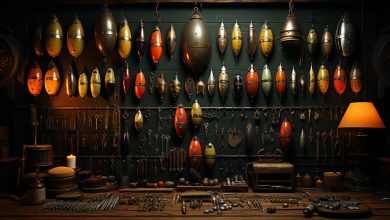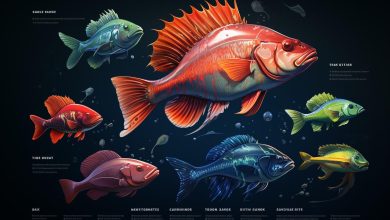Mastering The Art Of Casting Tips And Tricks
Looking to become a master caster? Whether you’re a seasoned angler or just starting out, mastering the art of casting can take your fishing game to the next level. With a little bit of practice and some helpful tips and tricks, you’ll be able to effortlessly cast your line with precision and accuracy every time.
In this article, we’ll cover everything from the basics of casting to advanced techniques that will elevate your skills. We’ll also provide troubleshooting tips for common casting problems so that you can avoid frustration on the water.
So grab your rod and reel and get ready to learn how to perfect your casting technique!
The Basics of Casting
You’re going to feel more confident in your casting skills after learning the fundamental techniques.
First things first, it’s important to understand the different casting techniques such as overhead cast, roll cast, and sidearm cast. Each technique has its own purpose and can be useful in different fishing scenarios.
To start, focus on mastering one technique at a time before moving onto the next.
One common mistake beginner anglers make is using too much force when casting. This can result in inaccurate casts and even lead to injury. Instead of relying on brute force, practice using smooth and fluid motions while maintaining proper form.
Keep your elbow close to your body and use your wrist to control the direction of your cast.
With consistent practice and attention to detail, you’ll soon be ready for more advanced techniques like double hauling or distance casting.
Advanced Techniques
When it comes to casting, you may already have the basics down pat, but what about more advanced techniques?
In this subtopic, we’ll explore some key points that can help take your casting game to the next level.
You’ll learn how to adjust your technique for different weather conditions and different types of lures, as well as how to tailor your cast for specific fish species.
With these tips in mind, you’ll be able to cast with confidence no matter what challenges come your way.
Casting in Different Weather Conditions
If you’re not careful, casting in difficult weather conditions can turn into a complete disaster. Fishing in rain or casting in snow requires a different approach compared to casting on a sunny day. Extreme weather conditions demand that you adapt your technique accordingly.
Fishing in Rain: Casting in wet conditions can make the fishing experience challenging, but with the right techniques, it’s possible to cast successfully. One of the best tips for casting during rainy weather is to keep your line dry. You can do this by using a waterproof fly box and keeping your hands as dry as possible. Additionally, try to shorten your casts and aim for accuracy rather than distance. The shorter casts will help reduce the amount of water that gets on your line and improve accuracy since windy conditions are typical when it rains.
Casting with Different Lures: Now that you know how to handle various weather conditions, let’s focus on different types of lures. Using the wrong lure for the fish species or water type could lead to failure, regardless of how well you cast. Therefore, before deciding which lure to use, take some time to observe what’s happening around you. This includes looking at the type of vegetation underwater or any signs of fish movement on top of the water surface.
Casting with Different Types of Lures
Get ready to elevate your fishing game by learning how to cast with various types of lures. Whether you’re a beginner or an experienced angler, understanding the top lures and techniques for success can make all the difference in catching that big fish.
Here are 3 essential tips to help you master the art of casting with different types of lures:
-
Match your lure to the water conditions: If it’s a clear day, use a natural-colored lure that blends in with the surroundings. If it’s cloudy or overcast, switch to brighter colors that stand out more in low light. Similarly, if you’re fishing in murky water, go for lures with rattles or vibrating blades to attract fish through sound.
-
Vary your retrieval speed: Experimenting with different retrieval speeds can also increase your chances of success when casting with different types of lures. For example, twitching or jerking a topwater lure can mimic the movements of prey and entice fish to strike. On the other hand, slowing down your retrieve and letting soft plastics sink can imitate injured baitfish and trigger a bite.
-
Use appropriate gear: Using proper gear is key to casting effectively with different types of lures. For example, using too heavy a line on light baits will cause them to sink too quickly and lose their natural action. Conversely, using too light a line on heavy lures will not provide enough casting distance or control.
Now that you know some tips for mastering casting with different types of lures, let’s move onto adjusting your casting technique for different fish species without skipping a beat!
Adjusting Your Casting Technique for Different Fish Species
To truly excel in your fishing game, you must adapt your casting technique to suit the specific species of fish you’re targeting. Matching bait selection with the behavior of the fish is key to success.
For instance, if you’re going after bass, it’s important to know that they are ambush predators and tend to hide out near cover waiting for their prey. This means that you should cast your lure near structures such as rocks or fallen trees where they may be lurking.
On the other hand, if you’re targeting trout, which are more likely to feed on insects, a more delicate approach might be necessary.
Understanding fish behavior can also guide how fast or slow you retrieve your lure. Some fish species prefer a slower retrieve while others like a faster one. It’s important to do some research beforehand on the type of fish you’ll be targeting and adjust your casting technique accordingly.
By doing so, you increase your chances of getting a bite and reeling in that trophy catch.
As with any skill, mastering the art of casting takes time and practice. But by adapting your technique based on the species of fish you’re after and understanding their behavior patterns, you’ll be well on your way to becoming an expert angler.
Practice Makes Perfect
By consistently putting in effort, you can become more adept at the techniques discussed in this section. Improving accuracy and building muscle memory are key to mastering the art of casting. It’s important to start with the basics and practice regularly to ensure that your technique becomes second nature.
When it comes to practicing, don’t be afraid to challenge yourself by casting in different conditions or trying out new techniques. Use a target or marker on the ground or water to help improve your accuracy and aim for consistency in your casts. Remember that consistent practice will not only help you improve your skills but also build confidence when facing different fish species and fishing situations.
Now that you’ve honed your casting skills through regular practice, it’s time to troubleshoot any common problems that may arise during actual fishing trips.
Troubleshooting Common Casting Problems
When it comes to mastering the art of casting, dealing with environmental factors is a crucial skill. Wind can easily disrupt your cast and ruin your chances of catching fish.
It’s also important to be aware of any issues with your equipment that may be hindering your performance.
Lastly, addressing problems with your casting technique can greatly improve your accuracy and distance. By taking these factors into consideration, you can troubleshoot common casting problems and become a more successful angler.
Dealing with Wind and Other Environmental Factors
Navigating the unpredictable forces of nature can make or break your angling success. From dealing with crosswinds to casting in tight spaces, it’s important to know how to adapt to different environmental factors.
When facing strong winds, try adjusting your casting angle or switching to a heavier lure that can cut through the gusts. If you’re fishing in a narrow area, use shorter casts and aim for precision rather than distance.
It’s also helpful to be aware of other environmental factors such as water temperature and current speed, as these can affect the behavior of fish and the way they respond to your bait. By paying attention to these details and making small adjustments as needed, you’ll be able to increase your chances of reeling in a catch even when faced with challenging conditions.
As you continue practicing, you may discover new techniques that work best for you and help improve your casting skills overall. With this knowledge under your belt, you’ll be better equipped not only for dealing with environmental factors but also for correcting issues with your equipment in order to achieve optimal results on every angling adventure.
Correcting Issues with Your Equipment
Get ready to fix any equipment issues that may arise during your fishing trip – correcting these problems can help you achieve better results and have more fun on the water! Maintaining equipment is crucial in ensuring that everything runs smoothly while you’re out casting your line.
Here are some common mistakes to avoid and tips for keeping your gear in top shape:
-
Keep your reel clean and lubricated. Use a cloth to wipe down the exterior after each use, and oil the internal parts regularly.
-
Check your line before heading out. Make sure it’s not tangled or damaged, as this can cause issues with casting accuracy.
-
Inspect your rod for any cracks or chips. If there are any signs of damage, it’s best to get it repaired before hitting the water.
-
Have spare hooks, sinkers, and other small accessories on hand in case anything gets lost or broken.
By taking care of your equipment and being prepared with backup supplies, you’ll be able to focus more on perfecting your casting technique and enjoying the sport of fishing.
Speaking of which…
Now that we’ve covered how to maintain your gear, let’s move on to addressing problems with your casting technique.
Addressing Problems with Your Casting Technique
You can improve your fishing experience and increase your chances of catching more fish by honing in on your casting skills with a few simple adjustments and the age-old saying, practice makes perfect. However, even the most experienced anglers make common casting mistakes that can lead to frustration and lost catches. By correcting your form, you will be able to cast farther, more accurately, and with less effort.
Here are some common casting mistakes along with tips for correcting them:
| Common Mistake | How to Correct |
|---|---|
| Breaking wrist too early | Keep your wrist locked until you reach the end of the forward cast. |
| Jerky movements | Smoothly accelerate and decelerate throughout the cast. |
| Improper grip | Hold the rod with a loose but firm grip using all four fingers and thumb. |
| Poor timing | Wait until the line is fully extended behind you before beginning the forward cast. |
By addressing these issues in your casting technique, you’ll be well on your way to mastering this essential skill for successful fishing trips. Once you have corrected these mistakes, it’s time to put your newly improved casting skills to the test!
Putting Your Casting Skills to the Test
So, you’ve mastered the art of casting and you’re ready to put your skills to the test!
Choosing the right fishing spots can be crucial in determining your success.
Applying your casting skills in real-world situations is where you’ll see just how well you’ve honed your abilities.
Whether you’re celebrating your successes or learning from your failures, every experience will help you grow as an angler.
Choosing the Right Fishing Spots
Finding the ideal fishing locations demands a keen understanding of various factors to ensure your efforts yield optimal results.
Firstly, it’s crucial that you find the perfect bait for the fish species you’re targeting. This is because different fish have unique preferences and tendencies when it comes to feeding. You can research online or ask fellow anglers in your area for advice on which baits work best.
Secondly, understanding water currents is also key to finding great fishing spots. Water currents affect where fish are located and how they move, making them an essential factor to consider when choosing a location. Look out for areas where there are obstructions such as rocks or logs; these can create eddies that cause water currents to slow down, making them attractive spots for fish.
With this knowledge, you’re now ready to apply your casting skills in real-world situations by learning how to present your bait effectively and accurately cast towards potential hotspots without spooking the fish!
Applying Your Casting Skills in Real-World Situations
Now that you’ve got a solid understanding of bait and water currents, it’s time to take your fishing game to the next level by putting your casting skills into action. However, real-world challenges may arise, such as different weather conditions or varying water depths. It’s important to adapt your techniques accordingly.
One tip is to practice casting in various conditions before heading out on a fishing trip. This will help you become comfortable with adjusting your technique based on wind direction and speed, as well as the distance between you and the fish.
Additionally, pay attention to the type of fish you’re targeting and their behavior patterns. Some fish may be more easily spooked than others, so a gentler cast may be necessary in those situations. By being adaptable and attentive to these factors, you can increase your chances of success while out on the water.
As you continue to refine your casting skills in real-world situations, celebrate your successes and learn from your failures without getting too discouraged or overly confident. Remember that each fishing trip presents its own unique set of challenges and opportunities for growth. With patience and persistence, you’ll soon master the art of casting and become an even more skilled angler overall.
Celebrating Your Successes and Learning from Your Failures
You’ve put in the hard work and dedication to refine your casting skills, but don’t forget to reflect on your progress and embrace both successes and failures as learning opportunities.
Celebrate when you make a perfect cast or catch a big fish, but also take the time to analyze what went wrong when you miss your target or lose a fish.
Reflecting on your progress is an important part of improving your overall angling abilities. Take note of how far you’ve come since starting out, and recognize areas where you still have room for growth.
Embracing mistakes can be difficult, but it’s essential for becoming a better angler. Don’t beat yourself up over missed casts or lost fish; instead, use those experiences as lessons to learn from and improve upon for next time.
By celebrating successes and embracing mistakes, you’ll continue to develop your casting skills and become a more successful angler overall.
Conclusion
Congratulations! You’ve now learned the basics of casting and some advanced techniques to take your skills to the next level. However, you may be thinking that all this information is overwhelming and wonder if it’s worth the effort.
But let us remind you that practice makes perfect. The more you cast, the better you’ll become at it. Remember to take breaks when needed, but don’t give up on mastering this art form. Soon enough, casting will become second nature to you.
And think about the endless possibilities that come with being a master caster – catching bigger fish, entering competitions, impressing your friends and family with your new skills. So keep practicing and troubleshooting any issues along the way.
In conclusion, don’t let doubts hold you back from mastering the art of casting. With dedication and practice, anyone can improve their casting skills.
So grab your rod and reel and go out there – show off what you’ve learned and catch some fish!



